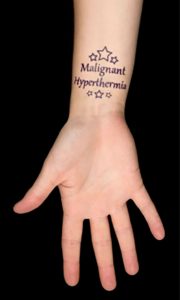Introduction
Tattooing has gained tremendous popularity over the last 20 years. In medicine it is used for corneal tattooing, gastrointestinal tattooing during endoscopy, permanent makeup, the camouflage of scars, and to mark a field for radiotherapy.1 More recently it has been used as a vaccination technique in research2 and for the identification of a site for biopsy examination.3 An emerging application is for the identification of life-threatening conditions that would require special attention during emergencies, such as in patients with a pre-disposition to malignant hyperthermia. Malignant hyperthermia is a genetic defect of uncontrolled hypermetabolic skeletal muscle response to anaesthetic-triggering drugs. The use of volatile anaesthetics or suxamethonium chloride (succinylcholine) in patients who are predisposed to it leads to increased release of calcium from the sarcoplasmic reticulum, which can be fatal if dantrolene sodium is not given promptly.4,5 A 47-year-old man known to have the condition presented to our department for a procedure that required a general anaesthetic. It was uneventful, but he was not wearing a medical bracelet, as his employers would not allow him to wear one at work because it was hazardous. If he had had a life threaten-ing facial injury, loss of consciousness, airway obstruction, or was unable to communicate because of intoxication, an emergency general anaesthetic might have been given with-out the staff being aware of his history. A medical alert tattoo would have warned them of this risk (Fig. 1).

DiscussionMedical alert tattoos can be used as a pragmatic permanent tool to alert the surgeon, paramedics, or anyone in public places in case of emergency. They can also help reduce the stigma around serious conditions, as they bring them out into the open. However, one should keep in mind that tattoos may fade with time and become blurred,6 which makes them difficult to read, or the words could be misspelled during the procedure.7 The alert tattoo is not intended to make a political statement or express an artistic side, it is meant to notify medical professionals that the patient has a serious condition in case of emergency. The tattoo must be easily recognisable to first responders. Organisations like the British Malignant Hyperthermia Association8 could produce guidelines on the optimal placement and general shape for tattoos, as currently there are none. To our knowledge, no complications have been reported on this type of tattoo. With more and more of the public having tattoos, this may be an impetus to consider having one that could save your life.
Conflict of interest
We have no conflicts of interest.
Ethics statement/confirmation of patients’ permission
Not applicable.
